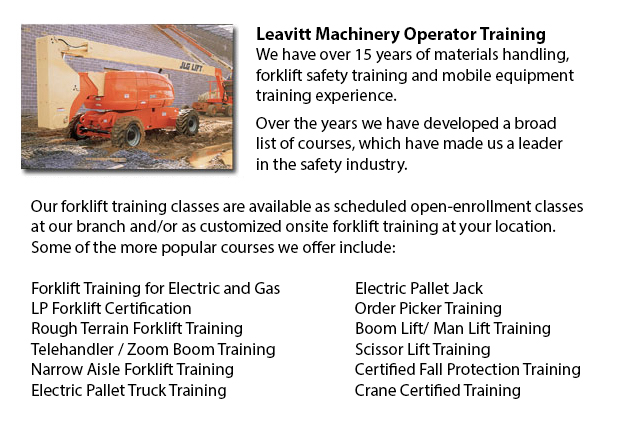
Manlift Training Marysville - Different manlift training courses consist of the review and content of manlift devices. An essential portion of the program is the practicum where students show their practical ability and knowledge to operate the manlift safely. A prerequisite to Manlift training is the fall protection training, which can be incorporated in the training based on the particular needs of the client.
Course Content
The course comprises the following areas of instruction: pre-shift equipment check and work area survey requirements; the impact of performing unsafe acts or operating unsafe machines, Lifting device equipment definitions, Review of load capabilities, safety decals and specific machine requirements, Review of related sections of the OSHA Standards and the CSA Standards and Review site particular Hazards, together with controls for safe operation of a lifting device.
Demonstration and Evaluation Content
Demonstration and evaluation content includes: Proper personal protective equipment or also known as P.P.E. as needed; Making use of a signaler or a spotter when required; using a lift only on level and solid ground; Using the right fitting harness or fall arrest device; Aware of load restrictions and all that. and other specs set out by the manufacturer; Operating the lift with all other workers clear of the job location; Having all associated machinery safely stored on the lift platform; Pre-shift work area survey and machine check; Isolating off the work place when major work projects are to be completed; and ensuring a smooth and safe operating speed for different plant conditions
Each person will be tested to make certain they can safely and efficiently utilize your site-specific machine.
Manlift Safety
Because the manlift is capable of lifting materials and personnel more than 20 feet in the air, these equipment pose a particular amount of risk and can be dangerous machines if not operated correctly. As the danger is so apparent, lift owners and operators are careful to correctly maintain their equipment and follow proper operating procedures and safety measures. The ratio of accidents involving this particular equipment is fairly low.
The safe operation of the scissor lift, manlift and the boom lift is up to the operator of that machine. They have to know all of the responsibilities that go with operating the equipment and how to use the lift vehicle safely. The most basic safety features on the machine are safety decals and the operating manual. These show essential information regarding the operating procedures, safety machines and maintenance.
Newer lift models will come with guidebooks and decals in place. Technically, the operating handbook should be kept on the lift itself. If you are purchasing a second-hand lift, it is essential to make sure that the manual is included and that vital decals haven't been painted over. The restraints which prevent operators from falling and the guardrails are other vital safety features. These are standard and mandatory on all types of lifts.
-
Manlift Safety Training Marysville
Manlift Safety Training Marysville - It is important for experienced Manlift operators to be aware of the connected hazards which come with particular types of scissor lifts. They must be able to operate the scissor lift in a way that protects not on... More -
Forklift Operator Certification Marysville
Forklift Operator Certification Marysville - Forklift operator certification is normally required for employees working in industrial, warehouse or construction environments to guarantee the safe utilization of forklifts. Workplace training need to f... More -
Crane Training School Marysville
Crane Training School Marysville - The crane training school offers industry-relevant programs. Courses provide trainees with learning outcomes that match present industry demands. Our small class sizes combine hands-on experience and theory. Our ind... More -
Heavy Equipment Training Marysville
Heavy Equipment Training Marysville - Normally, the different kinds of heavy equipment training are divided into 2 categories of machines: those that have rubber tires and tracked vehicles. Tracked vehicles comprise items like cranes, bulldozers and... More -
Counterbalance Forklift License Marysville
Counterbalance Forklift License Marysville - Forklifts, when operated by fully trained workers, are a major advantage to companies. We provide a thorough training program covering all aspects of operating a powered lift device. Counterbalance forklif... More -
Boom Lift Safety Training Marysville
Boom Lift Safey Training Marysville - Boom lifts are a type of elevated work platform or aerial lifting device which are normally utilized in warehousing, construction and industry. Boom lifts could be used in virtually any environment due to their v... More -
Aerial Lift Training Marysville
Aerial Lift Training Marysville - An aerial work platform is a mechanical access platform. This particular machinery provides access to otherwise not accessible areas for equipment or people. Likewise called an elevating work platform or aerial devic... More -
Aerial Boom Lift Training Marysville
Aerial Boom Lift Training Marysville - For people who operate or supervise the utilization of aerial lift platforms, right aerial boom lift Training is necessary. The aerial lift platform is for lifting people, materials and tools to elevated work lo... More

Forklift Training Marysville
TOLL FREE: 1-888-254-6157
Marysville, Washington
forklifttrainingmarysville.com
Email Us
About Us


